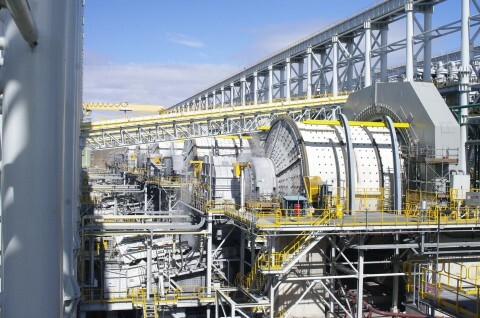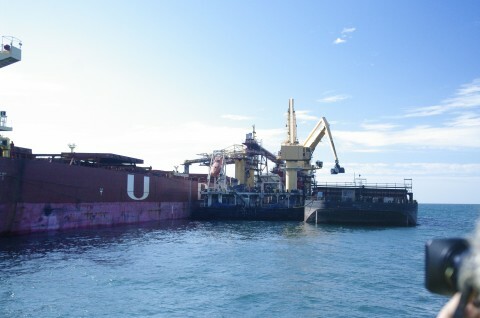Hematite has been king in the Pilbara for the past 50 years. Its relative process sheet simplicity and high iron content has made it a global favourite.
However, that is starting to change. Could the days of direct ship ore be done?
“The head grade of the ore is coming down,” Zeng said.
“In the 1970s it was in the high 60% range,” he said.
“Now it is in the high 50% range and the impurities are increasing.
“I believe a project like Sino Iron will extend the life of the Pilbara.
“With the decreasing head grade and impurities increasing if Western Australia wants to keep and maximise its competitiveness, WA needs magnetite mines.”

Five of the six autogenous grinding mills at Sino Iron. These are the largest AG mills in the world.
Zeng believes the fact magnetite needs beneficiation is another plus for WA.
“Sino Iron delivered a new generation of iron ore production,” he said.
“It has introduced downstream processing and for that you need strong manufacturing expertise.
“That’s the benefit we bring to WA iron ore production.”
For Zeng the manufactured nature of magnetite will deliver consistency and the ability to get a high iron content will give it the edge over its more fashionable hematite cousin.
“Magnetite, in my view, will be an important part of the overall iron ore export from Australia,” he said.
“This product is a manufactured product.
“This product, over time, because of the nature of the consistency and the less pollution it generates will generate a premium over DSO.
“Pollution is a very critical issue for the Chinese economy.”
So far, though, magnetite is not delivering that premium.
It also is a much more expensive process than hematite.
CPM’s Sino Iron project is a key example of the challenges facing magnetite operations.
Its magnetite comes out of the ground with a head grade of about 30% to 32% iron. That means it has to be beneficiated.
For that CPM has six production lines. Each line contains an autogenous grinding mill and a ball mill. Those AG and ball mills are the largest in the world.
To get process water in the dry Pilbara CPM built a 51 gigalitre desalination plant – the same size as the one installed south of Perth to help bolster that city’s water supply. It also built a 450 megawatt power station – large enough to power Canberra.
There was also a trans-shipment facility – the first of its kind in Western Australia that can load a mini-cape vessel, ships holding about 116,000 tonnes, in two days. That is about the time it takes for one of the iron ore majors to load a cape size vessel holding double that.
In the pit CPM is running the world’s largest hydraulic excavator the RH400 and one of the largest haul truck types – the 363t carrying Terex MT6300.
It was little surprise then that such an infrastructure heavy project ended up suffering budget and timeframe blowouts.
Initially Sino Iron was expected to cost $US2.5 billion and be at full speed by the end of 2011.
The company only commissioned its fifth and sixth production lines this year and the bill is north of $US10 billion.

One of CITIC Pacific Mining's trans-shippers loading a mini-cape vessel.
The project is in the process of ramping up to its full production of 24 million tonnes per annum, a run rate it expects to reach in 18 to 24 months’ time.
Zeng admits mistakes were made in the early days of the project.
“This plant experienced some a very difficult and challenging period of time,” he said.
“We started construction at the peak of the mining boom.
“It was hard to get skills.”
Then there was the approach CPM took to develop its site.
It decided to go away from conventional magnetite processing wisdom and truncate its processing lines.
That meant there was no handbook for the plant. Lines one and two were particularly problematic.
“We learnt as we went,” Zeng said.
When it came to line three, that line ran from the moment the button was pressed.
By the time it got to lines five and six CPM had the process well nailed down. Those two lines came on under budget and more than 200 days ahead of schedule.
Zeng would not say what that budget was, however, nor what the total capital cost for the plant was.

























